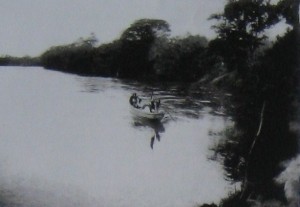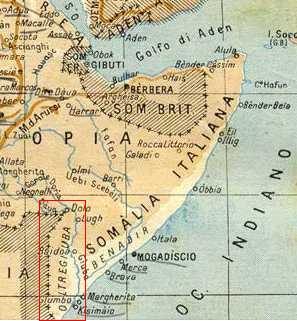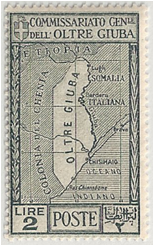ALBUM – view my Oltre Giuba album
Fast Facts
Region: East Africa
Group: Italian Colonies in East Africa
Classification: Colony
Prior Regime: British East Africa
Key Dates:
1924, Jul 15 – Anglo-Italian Juba River Agreement
1925, Jun 29 – Jubaland ceded to Italy from the British to become Oltre Giuba
1926, Jun 30 – Oltre Giuba incorporated into greater Italian Somaliland
Following Regime: Italian Somaliland
Scott Catalogue: (Oltre Giuba) #1-35, B1-B6, E1-E2, J1-J10, Q1-Q13
Pick Catalogue: none
History


One outcome, however, was the Anglo-Italian treaty of July 15, 1924, under which a northern portion of the Kenya territory, commonly called Jubaland or Trans-Juba, would be ceded to Italy. On June 29th, 1925, the treaty took effect, the British flag was lowered and Oltre Giuba, the newest Italian colony was born. The new colony didn’t last long, however, as one year later it was incorporated into greater Italian Somaliland.
Stamps
 ALBUM
ALBUM
On July 29th, 1925, the day of the transfer to Italy, contemporary Italian stamps overprinted “OLTRE GIUBA” in black were issued and consisted of a set of 15 definitives, 10 postage dues and 13 parcel post stamps. Five additional Italian definitive overprints were issued in different denomination over the following few months as well as two special delivery stamps.
As was the usual procedure for many Italian colonies, specific commemorative sets from Italy were issued with overprints from the various colonies. For Oltre, Giuba, two such sets were issued. The first was the 1925 King Victor Emmanuel’s Jubilee celebrating the 25th year of reign. This set of 3 stamps was issued with two perf varieties (11 and 13½) and was also overprinted and issued Cirenaica, Tripolitania, Eritrea, and Somalia. The second was a set commemorating 700 years since the death of St. Francis of Assisi. Issued on 12 April, 1925, this set of 5 stamps was also issued in other colonies.
On 21 April, 1925, Oltre Giuba printed a set of 7 stamps specifically issued for the colony featuring a map of the territory which was inscribed “COMMISSARIATO GENLE / DELL’ OLTRE GIUBA”. Finally, on 1 June, 1925, Oltre Giuba was included in the Italian Colonial omnibus issues, a set of 6 semi-postal stamps with a common design issued across the Italian colonies in Africa. These stamps were only used until the end of June, 1925, when Oltre Giuba became a part of Italian Somaliland.
Banknotes
None, Italian currency was used throughout Italian Somilia area.
Links





The stamp collection I once had was pretty large and consisted of stamps only up to 1950. You should try and market this site to schools as a Geography instruction tool; a stamp collection is a fun way to learn geography.
Timothy, thanks for the encouragement. Maybe one day I will try and make it available for schools (I Love Geography), but there is still a lot of information I would need to include before it would be anywhere near complete — maybe in another 2-3 years. It is, I hope, interesting reading in an area which seems to be neglected from a historical context.
Michael